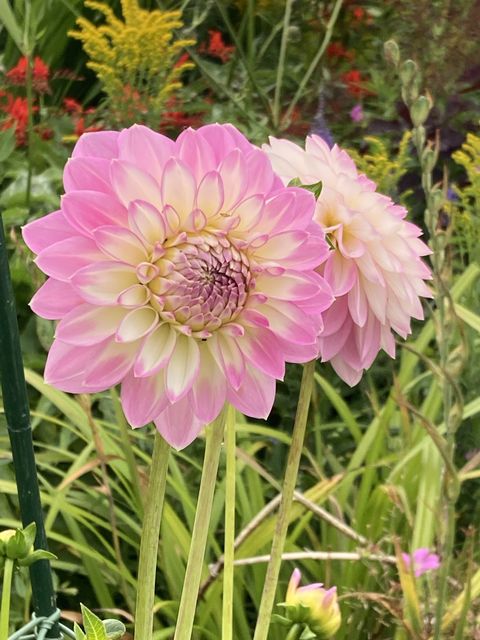Earlier this year, as winter slowly morphed into spring, I had a garden brainwave. I needed to put something right in the garden.
As you may know, I love tree ferns, and given any opportunity, I’ll add to my collection with the eventual dream of tending my own Jurassic forest. They appreciate our warm, moist climate, and as the back of our house doesn’t get much sun, it’s in this part of our Wicklow plot that they particularly thrive.
However, about four years ago, I planted some in the wrong place in the garden. Down towards the end of the garden is open and sunny, and more so since we removed a tree last year. These ferns just don’t like that.
Whether it was being planted under the canopy of a pine and the resultant lack of rain water or some other issue, they just weren’t happy. And if they’re not happy, I’m very unhappy!
Outside our kitchen was a paved cobblelock patch, an access pathway from the front garden. So, in March, during a ‘what if’ moment, I decided on radical garden action. I’d dig up large areas of the cobble, bring in loads of great organic compost and move the ferns all the way up the garden and replant, and then underlight them so, from inside, they’d look like a picture, summer or winter.
A little bit about the species, Dicksonia antarctica. This is a plant whose geographical distribution reaches from central Tasmania to southern Queensland.
Tree ferns are one of my favourite species, and using them in Ireland usually means they are evergreen while also being wonderfully tropical in appearance. I don’t wrap up the fronds in winter for protection and, so far, have never had an issue with them, even after a few days of snow or below-zero temperatures.
This is probably due, in part, to living near the coast and planting them within a sheltered garden, where there are many trees and shrubs. However, if you are in the midlands or in a frost pocket, you can protect the crown over winter with some hessian.
For this project, I was transplanting the tree ferns that hadn’t been in the ground for more than three years. I found the root system around them wasn’t as extensive as it can be. Previously, I’ve moved some from the front to back garden and was amazed at the extent of the fibrous roots. Since April, I have been nursing them carefully — despite our so-far wet summer, I’ve been out drenching their trunks on a regular basis.
Each fern is different to the next in every way. Some may be more hardy than others although they are the same species, and some, in mid-summer, are about to produce a second plume of new foliage. I researched extensively and found that, if you do move them when they are just about to sprout new foliage, the fronds may come out a bit wonky, and indeed that’s happened with one of mine.
Don’t be scared to have a single species in the front of the house. I have a grove of birch trees and now a grove of ferns in the back. How you arrange them is really important. I see many tree ferns just planted straight up but these give you the ability to shape a landscape. I have underlit them with spotlighting and, at night, they are very dramatic.
The only other planting I used at the base were smaller ferns. Dryopteris wallichiana is an elegant and architectural fern with an upright shuttlecock habit. I particularly like the dark, central rib that contrasts with the verdant foliage. I also used Polystichum setiferum, the native soft-shield fern.
Within their DNA, there are more and less frost-tolerant genes. As mentioned, I’ve never protected mine over winter and, despite the occasional blast, the cold doesn’t seem to bother them. Or maybe I’ve been lucky.
Planting trees and shrubs right up against a house is not always recommended but it can have its attractions. It’s counterintuitive because you think it will block the light but it can also gently filter the light through the greenery to great effect, creating a soft verdant veil.
Plant of the week
Dahlia ‘Arbatax’
Dahlia ‘Arbatax’ This month, the herbaceous borders at Powerscourt Gardens in Enniskerry, Co Wicklow, reach their peak, with dahlias taking centre stage. Dahlias are a great way of extending seasonal interest in your garden borders well into early autumn so it’s well worth a visit to these gardens to get inspired. ‘Arbatax’ is a beautiful, decorative dahlia with sumptuous white and pink petals.
Reader Q&A
The cranefly, whose larvae can wreak havoc on lawns by eating the grass roots
My lawn is being eaten by some creature and I’ve been told I need an organic lawn pesticide. I’ve heard Nemasys is the answer but can’t find it anywhere – is there any other solution?Maura
I’m guessing you have leatherjackets in your lawn — these are the larvae of craneflies and they eat the roots of your grass. The best solution is indeed Nemasys. It’s a biological control and now through to October is a good time to apply it while the soil is still warm. If you can’t find this product in your local garden centre or nursery, it is easy to find online.
Submit your gardening questions to Diarmuid via his Instagram @diarmuidgavin using the hashtag #weekendgarden

